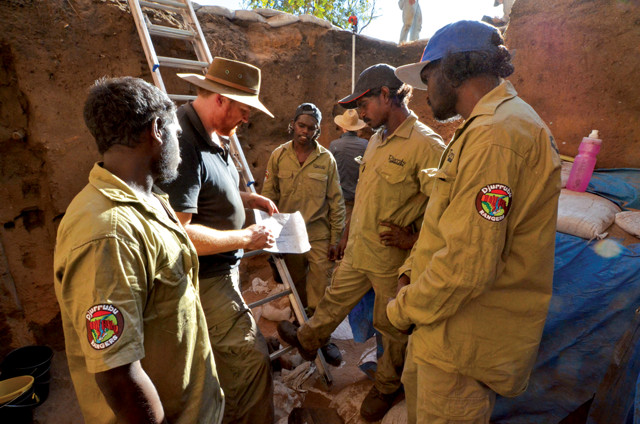
by Mary Caperton Morton Wednesday, October 18, 2017

Chris Clarkson of the University of Queensland talks with Djurrubu Aboriginal Rangers at the Madjedbebe excavation site in Australia's Northern Territory. Credit: Dominic O'Brien, Gundjeihmi Aboriginal Corporation.
Analysis of sediments surrounding a trove of artifacts discovered in northern Australia suggests the first humans arrived on the continent about 10,000 years earlier than previously thought, a finding that has implications for the hypothesized role of humans in the extinctions of Australian megafauna.
Since its discovery in 1973, the Madjedbebe rock shelter site in Australia’s Northern Territory has yielded more than 10,000 artifacts, including stone tools, plant remains, pigments and bones. Using a combination of radiocarbon and luminescence dating techniques, a team of researchers dated the sediments in which the artifacts were found, as well as layers above and below. They reported in a study in Nature that humans occupied the site as early as about 65,000 years ago, when Australia was much wetter and colder than it is today. The findings match previously published genetics studies that place the first humans in Australia roughly 70,000 years ago.
The new dating calls into question the long-standing idea that humans, arriving on the continent, decimated Australia’s giant kangaroos, wombats, tortoises and other megafauna about 45,000 years ago.
“Previously, it was thought that humans arrived and hunted [the megafauna] out or disturbed their habits, leading to extinction, but these dates confirm that people arrived so far before that they wouldn’t be the central cause of the death of megafauna,” said study co-author Ben Marwick, of the University of Washington, in a statement. This work suggests “a vision of humans moving in and coexisting [with the megafauna], which is quite a different view of human evolution.”
© 2008-2021. All rights reserved. Any copying, redistribution or retransmission of any of the contents of this service without the expressed written permission of the American Geosciences Institute is expressly prohibited. Click here for all copyright requests.